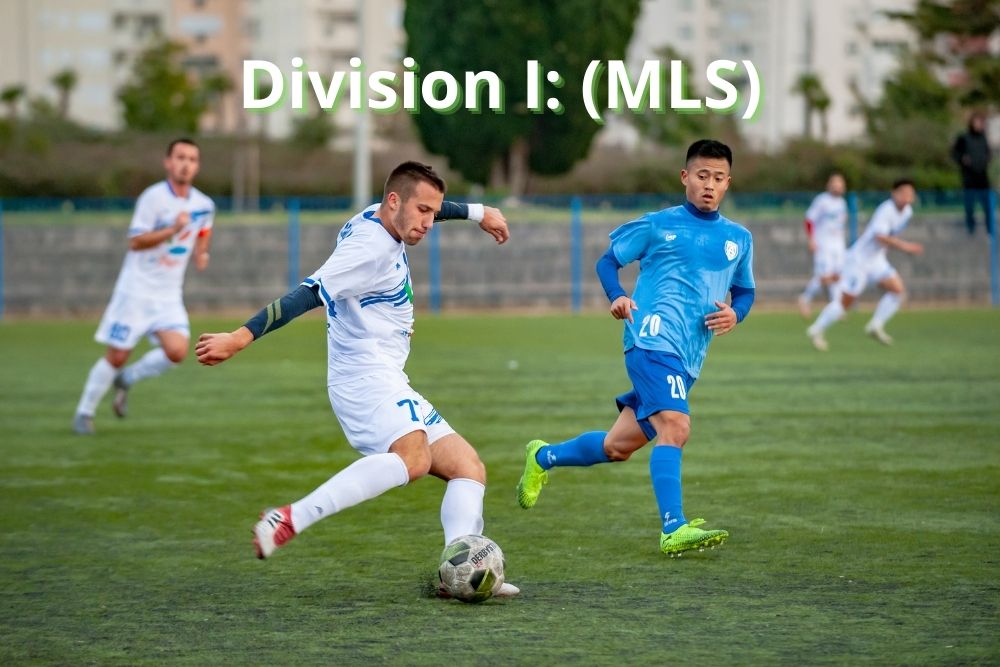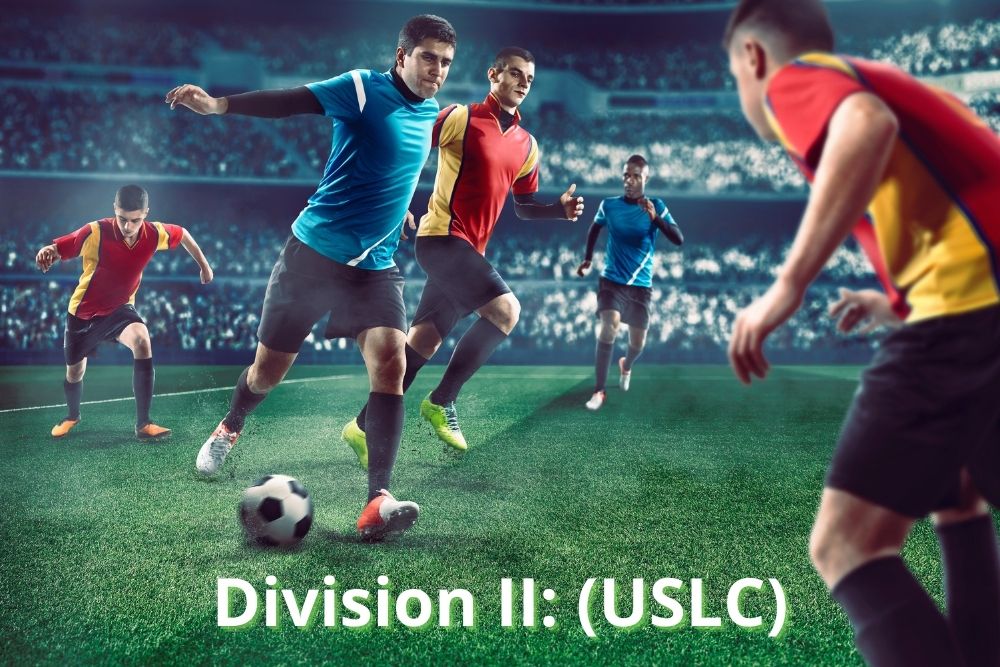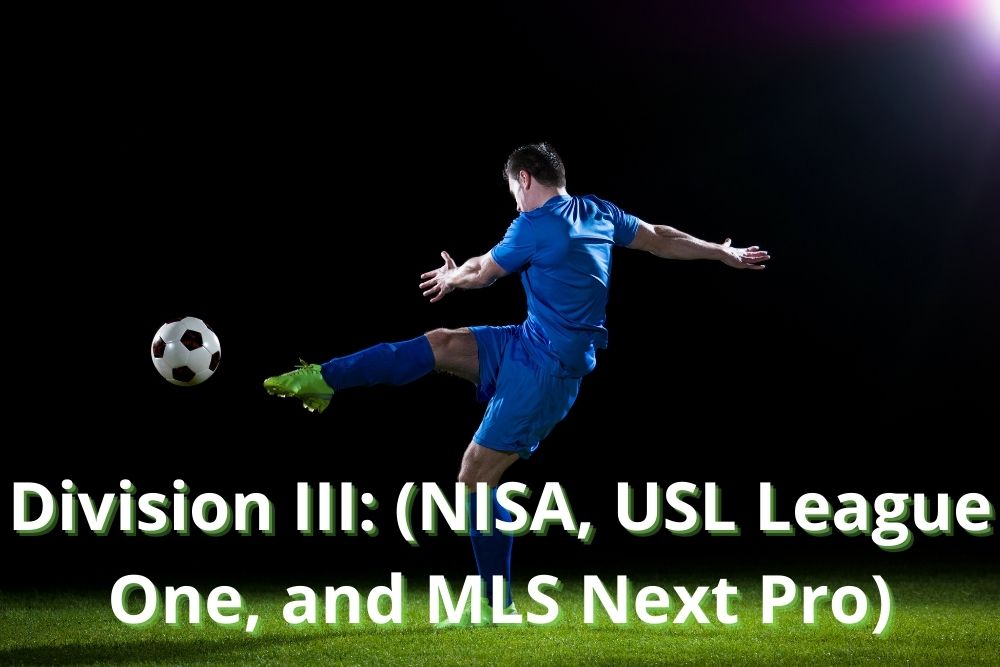The entire league system in US soccer is only a couple of decades old, which makes it younger than most clubs in Europe. It’s tied to an even more confusing hierarchy that connects pro and semi-pro leagues.
That’s why as a new fan of US soccer, when you decide to switch the soccer channel to MLS or USL, you will get stuck. It’s not so easy to wrap your head around the system.
The soccer leagues in the US work on more or less the same dynamics as NFL, NBA, or other major sports. Meaning, it has a fixed hierarchy and doesn’t allow promotion or relegation for teams.
Since the promotion/relegation of teams is a major component of soccer leagues worldwide, especially Europe, that’s where US soccer marks its first and most significant difference.
With that said, let’s now see how the US soccer leagues operate in a closed competition system.
Quick Navigation
How do soccer leagues work? (The Pyramid System)
The United States Soccer Federation (USSF) inaugurated their first league, the MLS, as an incentive to host the World Cup in 1994. However, it played its first official season in 1996.
Back then, this was the only sanctioned professional league with ten competing sides in the US. The absence of lower competitive leagues at the time forced the USSF to implement a No-promotion/relegation system, which made sense at the time.

But the USSF didn’t rethink this decision despite the growth in viewership and participation in soccer over the years. That has led to spiteful criticism which had to be dealt with at courts on several occasions.
Though this highly controversial MLS-Backed hierarchy might change in the future, it currently features a Pyramid System. Here, soccer leagues are separated into three Pro-Divisions.
The leagues are open to participation from teams belonging to the US and Canada, Bermuda, and Puerto Rico. The top-most spot in the pyramid is given to the MLS, the only sanctioned Division I league in the country.
Coming over to the second division, the USL Championship (USLC) has been the only Division II league in the US soccer Pyramid since 2018. The USLC is built upon the merging of former USL First Division and USL Second Division and is the largest second-division league in the world.
But things quickly change as you jump even lower into the third division. This is where the trio of the National Soccer League-League One, National Independent Soccer Association, and MLS Next Pro take over. Up till here, all four leagues are under the umbrella of professional soccer.
However, there’s also a horde of other semi-pro and amateur leagues that make up the Pyramid System of US soccer.
But the USSF does not demarcate any difference of divisions and tiers beyond the 3rd division. Therefore, all the leagues below the 3rd division mark mostly go shoulder-to-shoulder in competition, talent, revenue, and incentives.
Depending on the respective league and the franchise, the players may or may not get paid in amateur and semi-pro leagues. Nevertheless, teams even belonging to amateur and semi-pro leagues get a shot at the Lamar Hunt US Open Cup and go toe-to-toe against continental champions.
How do men’s soccer leagues work?
With the US Soccer Pyramid understood, we now need to see how these leagues interact among themselves.
Since there is no rule for relegation/promotion, how do teams promote to higher leagues and demote to lower ones? Or how do they decide what division a league is put into?
The USSF has set several regulations for the entry of a league into either of the three divisions. If a league meets the criteria demanded by the USSF, it can enter into that specific division. It’s mostly financial, so a league kind of has to “buy” their way in.
Here’s a brief outlook on the requirements for a league to enter each division and a bit of background on how the league works itself.
Division I: (MLS)

Requirements
- At least 12 teams in the first season and 14 teams in the third.
- At least $70M of Net Worth of combined owners, and $40M for the major shareholder.
- Teams must be from the Eastern, Central, or Pacific Time zone.
- 3/4th of the teams to be from areas with at least 1 million inhabitants.
- All teams must have enclosed stadiums and house at least 15,000 attendants.
- Contracts with cable operators or broadcasters to stream all seasonal games and championships.
Competition format (how it works)
The MLS, being the top-tier league in the highest division, runs from late February to mid-October each year. It has 28 teams put apart into two groups, the Western and Eastern Conferences. Each team reaches a total of 34 games per season.
After the season pulls its curtains in October, the Supporter’s Shield is awarded to the franchise with the best overall performance from both the conferences. But the action doesn’t end here.
The top 7 teams from each conference qualify for play-offs at the end of the season. There, they compete in a single-match knockout format where the winning finalist lifts the MLS CUP.
Division II: (USLC)

Requirements
- At least 8 teams in the first season, 10 teams in the third, and 12 teams in the sixth season.
- At least $20M of net worth of the chief owner.
- Teams must be from the Eastern, Central, and Pacific Time zones.
- 3/4th of the teams to be from areas with at least 750,000 inhabitants.
- All teams must have a stadium to house at least 5,000 attendants, not necessarily enclosed.
Competition format (how it works)
The United Soccer League Championship is a buffer zone between the lower leagues and MLS teams. Most elite players start their career here to be picked up by a higher team. Also, it is quite usual for MLS players to spend a season or two in the USLC to regain their form after injuries or bad performances.
USLC was born by merging two former leagues of the lower divisions; the USL first division and USL second division. It is the sole representative of Division II soccer in the US with 27 teams.
The USLC follows the same competition format as the MLS. All the teams are divided into Western and Eastern Conferences and have a 34-games schedule per season. The league runs from early March to late October.
After which, the top 10 teams from each conference qualify for the playoffs. The playoffs follow a single-match knockout format, with the winner lifting the USL Cup at the end.
Division III: (NISA, USL League One, and MLS Next Pro)

Requirements
- At least 8 teams in the league.
- At least $10M of net worth of the chief owner.
- All teams must have a stadium to house at least 1,000 attendants.
Competition format (how it works):
The third division of US soccer leagues mainly surrounds the idea of talent development programs. MLS teams are required to invest in youth and talent development programs. This is where they choose to have their reserve teams and franchises, like the MLS Next Pro, which is set to begin in 2022.
The National Independent Soccer Association is the highlight league here in this division with a spring-fall schedule. NISA hosts 13 teams and has outlined its plans for introducing a relegation/promotion system.
However, the league it hoped to promote its teams to, the North American Soccer League, was disbanded before these plans could bear fruit.
The third league in this division is the USL League One, which has 11 teams that will compete in 28 fixtures in a season before reaching the playoffs.
Semi-professional and amateur leagues

It’s hard to distinguish the standing of leagues beyond the 3rd division as the USSF doesn’t sanction these leagues or recognize their credibility. But the national association member of the USSF, the US Adult Soccer Association (USASA), does grant sanctions to leagues in the semi-pro division, giving them some credibility.
However, the NSL League Two and the National Premier Soccer League take the top spot in this division because of their dominant talent level and participation in the US Open Cup.
An age restriction binds the USL League Two for players out of these two. Since it operates in the summer or the off-season, this encourages young college athletes to make up the teams without losing their NCAA credibility.
On the contrary, the NSPL has no age restrictions. That’s why a combination of college players, retired pros, and high-level amateurs make up most of the teams.
The leagues here sometimes provide accommodations, transport, and even salary, but not always. That’s why they’re categorized as semi-pro and left out of the 3-tiered Pyramid of US soccer.
How do women’s soccer leagues work?
Women’s soccer took off in the US after the 1999 Women’s World Cup hosted by the US. There were talks of putting together a professional league even before the whistle blew for the final.
Consequently, the Women’s United Soccer Association was birthed in 2001, which was the only professional women’s soccer league of the time. After its demise in 2003, a number of different leagues exchanged handshakes and teams until the National Women’s Soccer League turned pages in 2011.
Since then, the NWSL has been the only sanctioned professional club in US Soccer. Though Women’s Independent Soccer League and USL Super League are lined up for the 2nd division status, there is still time till the leagues get sanctioned and included in the Pyramid system.
On a lower level (semi-pro), the United Women’s Soccer and Women’s Premier Soccer League take the top spots. The leagues have successfully sent teams to the first division.
They have a pool of talent for bigger sides to pick from. The USASA and not the USSF sanction these low-tier leagues.

National Women’s Soccer League
The NWSL is the top women’s soccer league in the US and has 12 teams enrolled.
The league follows the MLS in its seasonal schedule, beginning from early April and ending in late September. Through the season, each team gets to play 24 games. The team with the best overall performance wins the NSWL Shield.
From here on, the top 6 teams qualify for the playoffs, which are played on a single-match knockout format. The winner of the playoffs lifts the NSWL Championship, which is the equivalent of the MLS Cup for men.
The third major trophy the NWSL participates in is the NWSL Challenge Cup. This campaign is run throughout the year and mimics the importance of the Club World Cup for men.
School soccer tournaments in the US
Soccer tournaments on a school and college level are regulated by the National Collegiate Athletic Association or the National Junior Athletic Association.
Soccer leagues at this level are the perfect places for young talent to start their pro soccer journey. Enrolled schools and colleges push players for scholarships and even enrolments in professional clubs and franchises.
However, NCAA divides the hierarchy here into three divisions again. Division I consists of schools that have well-performing players on their side and are the favorites for attracting college and university scholarships.
Division II is a mid-tier league that sometimes has teams better than those in the top division. Still, they lack certain infrastructure and coaching facilities for players.
Meanwhile, the 3rd division schools of NCAA soccer are not granted scholarships for higher studies as they sit at the bottom of the Pyramid.
Other than these, the Disney Soccer Showcase, Jefferson Cup, Bethesda Premier Cup, and Nomads Thanksgiving Tournaments are top platforms for school and youth teams to test their wits against the best in the world.

Indoor soccer leagues
Indoor soccer is more common in the Northern US and Canada than it is in the rest of the world. The short season for outdoor soccer is a major reason why this fast-paced setting is adopted for soccer in the US.
The Major Arena Soccer League is the highest level of professional indoor soccer on American soil. It consists of 12 teams and plays from fall to spring.
The MASL split in 2014 and took up teams from the Professional Arena Soccer League to reach a high total of 23 teams in the 2015 season. Eventually, it merged with the PASL to form the Major Arena Soccer League 2.
The M2 is a developmental checkpoint for teams and players hoping to get to the topmost division. So, the M2 took the 2nd spot in the hierarchy to become the 2nd division league in Indoor soccer.

Conclusion
If you have steam blowing off from the top of your head, rest assured that it’s okay. The league system in the US is a complicated setup and is completely unique.
There are tons of criticism on how having a closed pyramid system for leagues kills the competitive nature among teams. But we’re still years away from seeing any change in these leagues’ current hierarchy and regulations.
That’s why understanding them while they still evolve is your best bet of staying up to date with American soccer.
Hi there, I’m Jay.
Soccer is everything in my life! My friends and I have created this blog with all our enthusiasm, passion, and understanding after years of playing pro soccer. Hope you will enjoy it!
